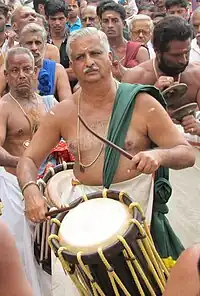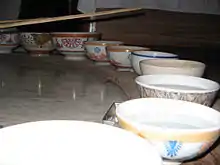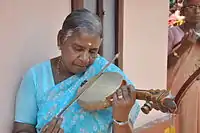
Lady playing pulluvan veena
Indian musical instruments can be broadly classified according to the Hornbostel–Sachs system into four categories: chordophones (string instruments), aerophones (wind instruments), membranophones (drums) and idiophones (non-drum percussion instruments).
Chordophones
Plucked strings
|
Bowed strings
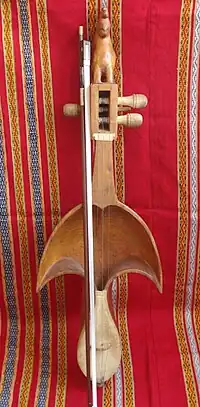
Tribal fiddle instruments called "Dhodro Banam" used by Santhal people in Eastern India.
- Chikara
- Dhantara
- Dilruba
- Ektara violin
- Esraj
- Kamaicha
- Kingri (string instrument)
- Mayuri Vina or Taus
- Onavillu
- Behala (violin type)
- Pena (musical instrument)
- Pinaka vina
- Pulluvan Veena - one stringed violin
- Ravanahatha
- Sarangi
- Classical Sarangi
- Sarinda
- Tar Shehnai
- Taus
- Villu Paatu - arched bow instrument
Other string instruments
Aerophones
Single reed
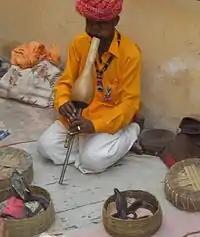
Snake charmer playing pungi
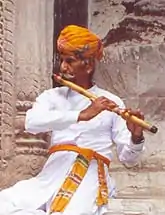
Bansuri player at Mehrangarh Fort at Jodhpur.
.jpg.webp)
Indian Harmonium
Double reed
- Kuzhal
- Mukhavina
- Nadaswaram
- Shehnai
- Sundari
- Tangmuri
Flute
Bagpipes
Free reed
Free reed and bellows
Brass
Membranophones
Hand drums
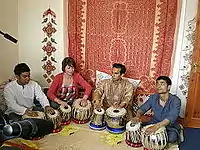
Learning to play tabla

Tumbaknaer, drum from Jammu and Kashmir for accompanying devotionals
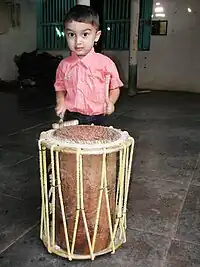
Chande of Yakshagana
Hand frame drums
- Daf, duf, or dafli – medium or large frame drum without jingles, of Persian origin
- Dubki, dimdi or dimri – small frame drum without jingles
- Kanjira – small frame drum with one jingle
- Kansi – small drum without jingles
- Patayani thappu – medium frame drum played with hands
Stick and hand drums
Stick drums

Chennakeshava Temple, 12th century A.D. Goddess playing an hourglass drum, possibly an udukai.
Idiophones
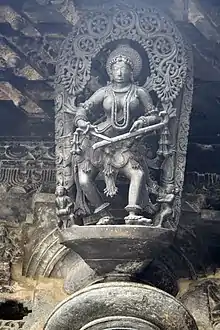
A medieval instrument, labeled nagaveena (snake veena), is a type of musical scraper.
- Chigggjha – fire tong with brass jingles
- Chengila – metal disc
- Eltathalam
- Gegvrer – brass vessel
- Ghaynti – Northern Indian bell
- Ghatam and Matkam (Earthenware pot drum)
- Ghunyugroo
- Khartal or Chiplya
- Manjira or jhanj or taal
- Nut – clay pot
- Sankarpjlnjang – lithophone
- Thali – metal plate
- Thattukanvjzhi mannai
- Yakshahgana bells
Melodic
- Jal tarang, ceramic bowls with water
- Kanch tarang, a type of glass harp
- Kashtha tarang, a type of xylophone
Hand harmonium
Dwarkanath Ghose (Dwarkin) modified the French pedal harmonium.
Electronic
- Roland HandSonic
- Electronic tanpura
- Electronic (digital) tabla
- Talameter
See also
References
This article is issued from Wikipedia. The text is licensed under Creative Commons - Attribution - Sharealike. Additional terms may apply for the media files.
